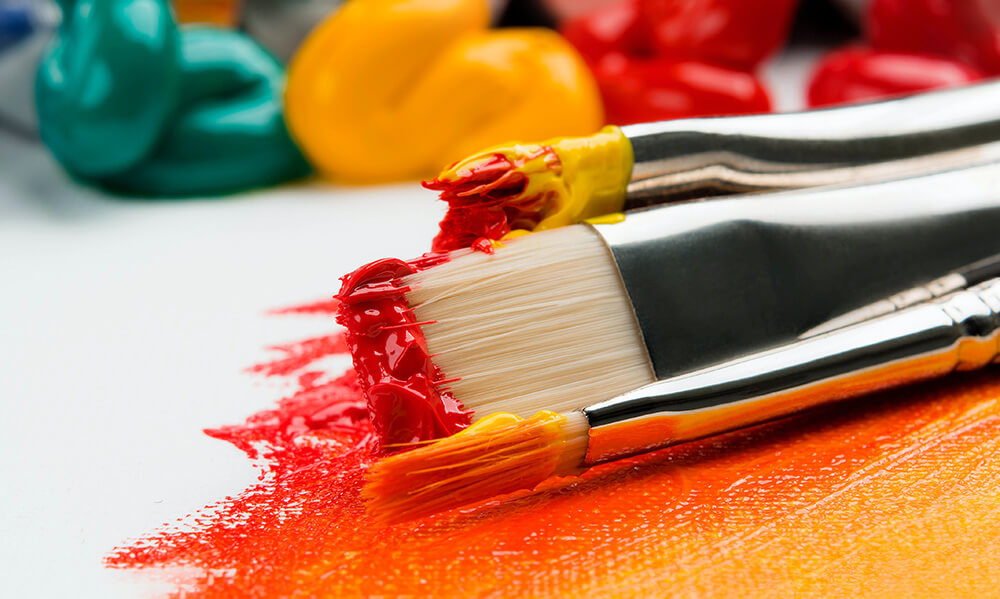Here’s a question: Which are better for artists, oil paints or acrylic paints?
Many beginning painters are told to use acrylic paint—but that’s NOT always good advice. And while there’s a certain prestige commonly associated with oil paintings, it honestly doesn’t matter if you use one or the other.
If you’re just starting out, it’s important to remember that a good painting requires good drawing skills first. Whether you’re using oil paint or acrylics, having a great drawing foundation is probably the best guarantee of success in the world of painting.
But assuming you’re already confident with your drawing skills, here are some reasons to choose acrylic paint over oil (and vice versa).
Pros and cons: oil paints vs. acrylic paint
1. Drying time
The main difference between oils and acrylics is drying time. Acrylic paint will dry within an hour, if not within fifteen minutes. Oil paints will stay wet for days or weeks, depending upon the humidity and temperature of your location.
That’s why I don’t always recommend that beginners choose acrylics—I, for one, am a slow painter, and if I had started out with a fast-drying paint, I might have become very frustrated with it. There are some retarders available which slow down the drying time of acrylics, but only for a few hours at most.
That said, some folks like to paint fast. So this one’s a toss-up, with no clear winner. It just comes down to what you prefer.
2. Mixing paint
Drying time influences so many other aspects of painting! Mixing acrylics is more difficult than mixing oils, simply because the acrylics are already beginning to dry. With oils you can mix colors for days on end, producing subtle color variations that you won’t have time to make with acrylics.
When it comes to mixing paint, I think oils are the clear winner.
3. Clean up (and toxicity)
You’ll also need to clean your brushes quickly after finishing painting with acrylics—within a half-hour, those bristles will be full of dried paint.
That said, you can clean acrylic paint with plain old water. Oil paints require Turpentine or Mineral Spirits (both of which can be harsh on skin, and contain fumes) and it’s a much longer process. Here’s a quick look at cleaning oil brushes to give you some idea.
For clean-up, acrylic edges out oils in my opinion.
4. Longevity
When it comes to longevity, oil paints have survived for hundreds of years, so their long-lasting quality is well known. Your oil painting could be around for 500 years! That being said, oil paints can discolor with age if not taken care of properly, something that acrylics don’t seem to do, although acrylics haven’t been around long enough for us to really know.
Oils have a proven track record, and the way they dry (essentially they “cure” rather than dry like acrylics) makes them my choice for longevity.
5. Color
Typically you’ll find that oil paints have more pigment in them, allowing richer, more vivid colors. Acrylic colors can also darken slightly as they dry, which means that the color you mixed may not be the exact color that ends up on the canvas.
Oils get the win on this one as well.
6. Cost
Oil painting supplies are more expensive than acrylics, so for students or hobbyists, it’s much easier on the pocketbook to stick with acrylic paints. As a bonus, you can use acrylic paints two ways: right out of the tube like oils, or diluted with water which lets you use them in an entirely different way, almost like watercolors.
Acrylics are much more budget-friendly for sure, especially if you pick student-grade acrylics to start out.
Is oil paint the right choice for you?
If you’re a slow painter, deliberate and cautious (perhaps used to spending hours on a single drawing) then I’d recommend oils. You’ll need to prop the windows open and wear your paint clothes, but at least you won’t have to rush.
A starter set of oil paint from Blick will cost about $30, and you can expect to pay $8-$10 for each natural hair bristle brush you purchase—you’ll probably want three or four of those at least.
To save a little money, make your first few paintings on paper instead of canvas. Just pick up some gesso to coat your paper with first, and don’t forget that Turpentine for cleaning up. (It’s available at any hardware store for much cheaper than your typical art supply store).
Or is acrylic the way to go?
If you’re concerned about toxicity of the paint, whether around children or pets (or yourself), acrylics might be the choice for you. An acrylic paint starter set will cost less than $15 for 12 colors, but you may end up needing to invest in some extras as well, like retarders, pastes, and gels, for the biggest possible range of texture and drying time available.
Brushes won’t set you back as much either, since you can use synthetic hair brushes for acrylic paint—they typically cost from $5-8 per brush. And the cleanup is free if you’ve got running water.
As you can see, acrylics ARE cheaper. Sometimes oil paintings will sell for more (making it worthwhile), but that’s really not a sure thing. If money is the bottom line, you’ll save a lot by avoiding high end oils.
If you can find an artist willing to let you dabble a bit with their paint before you make your decision, that will help a lot. Then just purchase the best paints you can afford.
Good luck, and happy painting!
This post may contain affiliate links.

